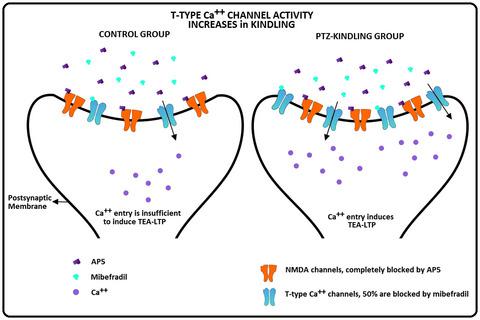Our official English website, www.x-mol.net, welcomes your feedback! (Note: you will need to create a separate account there.)
T-type Ca2+ channel activity increases in rat hippocampal CA1 region during kindling epileptogenesis.
SYNAPSE ( IF 2.3 ) Pub Date : 2020-03-25 , DOI: 10.1002/syn.22155 Erkan Aksoz 1 , Yildirim Sara 2 , Rustu Onur 3
SYNAPSE ( IF 2.3 ) Pub Date : 2020-03-25 , DOI: 10.1002/syn.22155 Erkan Aksoz 1 , Yildirim Sara 2 , Rustu Onur 3
Affiliation

|
Epileptogenesis is a dynamical process that involves synaptic plasticity changes such as synaptic reorganization of excitatory and inhibitory systems and axonal sprouting in the hippocampus, which is one of the most studied epileptogenic regions in the brain. However, the early events that trigger these changes are not understood well. We investigated short‐term and long‐term synaptic plasticity parameters and T‐type Ca2+ channel activity changes in the early phase of a rat kindling model. Chronic pentylenetetrazole (PTZ) application was used in order to induce the kindling process in rats. The recordings were obtained from hippocampal slices in the CA1 region at 25th day of PTZ application. Tetraethylammonium was used in order to induce long‐term potentiation and T‐type Ca2+ channel activity was assessed in the presence of mibefradil. We found that tetraethylammonium‐induced long‐term potentiation was not prevented by mibefradil in the kindling group in contrast to control group. We also found an increase in paired‐pulse ratios in the PTZ‐applied group. Our findings indicate an increase in the “T‐type Ca2+ channel component of LTP” in the kindling group, which may be an early mechanism in epileptogenesis.
中文翻译:

在引发癫痫发生过程中,大鼠海马 CA1 区的 T 型 Ca2+ 通道活性增加。
癫痫发生是一个动态过程,涉及突触可塑性变化,例如兴奋性和抑制性系统的突触重组以及海马中的轴突萌芽,海马是大脑中研究最多的致癫痫区域之一。然而,引发这些变化的早期事件并没有得到很好的理解。我们研究了大鼠点燃模型早期的短期和长期突触可塑性参数和 T 型 Ca 2+通道活性变化。使用慢性戊四唑 (PTZ) 应用来诱导大鼠的点燃过程。记录是在 PTZ 应用的第 25 天从 CA1 区域的海马切片中获得的。使用四乙基铵以诱导长时程增强和 T 型 Ca 2+在存在米贝拉地尔的情况下评估通道活性。我们发现,与对照组相比,点燃组中米贝拉地尔不能阻止四乙铵诱导的长时程增强作用。我们还发现 PTZ 应用组的成对脉冲比有所增加。我们的研究结果表明,点燃组中“LTP 的T 型 Ca 2+通道成分”增加,这可能是癫痫发生的早期机制。
更新日期:2020-03-25
中文翻译:

在引发癫痫发生过程中,大鼠海马 CA1 区的 T 型 Ca2+ 通道活性增加。
癫痫发生是一个动态过程,涉及突触可塑性变化,例如兴奋性和抑制性系统的突触重组以及海马中的轴突萌芽,海马是大脑中研究最多的致癫痫区域之一。然而,引发这些变化的早期事件并没有得到很好的理解。我们研究了大鼠点燃模型早期的短期和长期突触可塑性参数和 T 型 Ca 2+通道活性变化。使用慢性戊四唑 (PTZ) 应用来诱导大鼠的点燃过程。记录是在 PTZ 应用的第 25 天从 CA1 区域的海马切片中获得的。使用四乙基铵以诱导长时程增强和 T 型 Ca 2+在存在米贝拉地尔的情况下评估通道活性。我们发现,与对照组相比,点燃组中米贝拉地尔不能阻止四乙铵诱导的长时程增强作用。我们还发现 PTZ 应用组的成对脉冲比有所增加。我们的研究结果表明,点燃组中“LTP 的T 型 Ca 2+通道成分”增加,这可能是癫痫发生的早期机制。



























 京公网安备 11010802027423号
京公网安备 11010802027423号